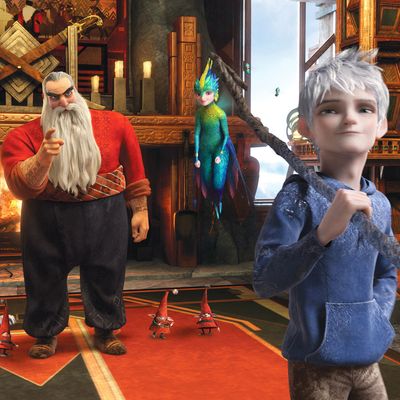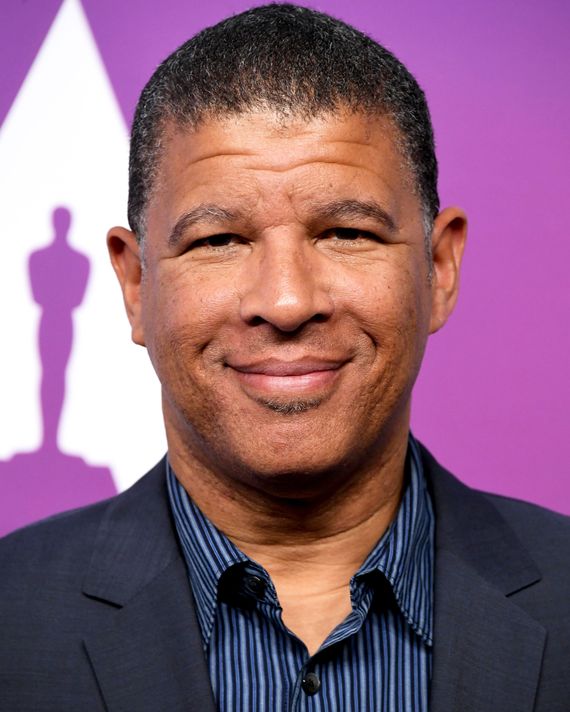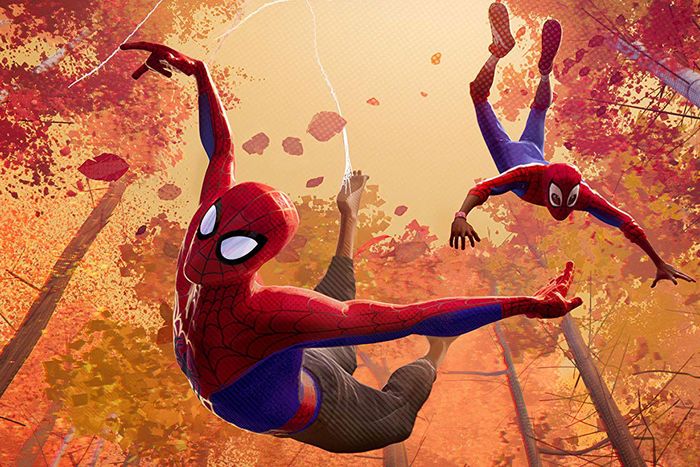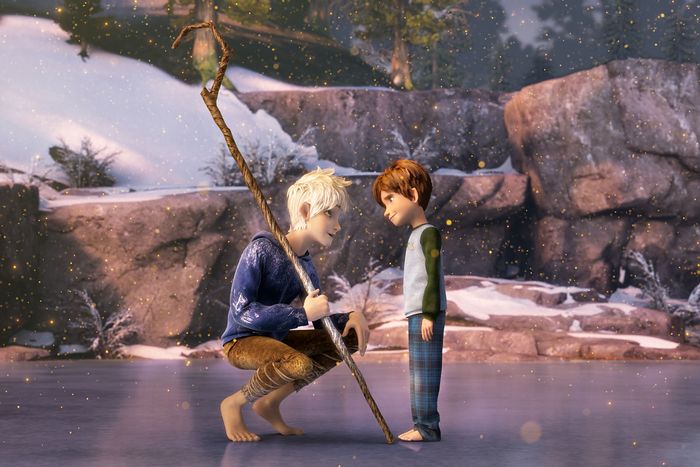
No, we didn’t dream this. There really was once an animated movie where Santa Claus, the Easter Bunny, the Tooth Fairy, and the Sandman teamed up with Jack Frost to fight the Bogeyman. It was called Rise of the Guardians, and it was shot by Oscar winner Roger Deakins (Blade Runner 2049, Kundun), scored by Oscar winner Alexandre Desplat, produced by Oscar winner Guillermo del Toro, and written by Pulitzer Prize winner David Lindsay-Abaire. The voice cast consisted of Alec Baldwin, Jude Law, Chris Pine, Isla Fisher, and Hugh Jackman. And it was directed by another eventual Oscar winner: Peter Ramsey, one of the three filmmakers behind last year’s wondrous Spider-Man: Into the Spider-Verse, a film that actually shares some conceptual, formal, and narrative similarities with Guardians.
Based on the children’s fantasy books by William Joyce and years in development, Rise of the Guardians opened in November of 2012 trailing clouds of expectation; it was DreamWorks Animation and Paramount’s big holiday release that year. But it proved to be a financial disappointment, the victim of audience apathy, lukewarm reviews (with a few notable exceptions), and a studio unsure of how to sell such a deliriously overstuffed, eclectic movie. Even so, for some of us, Guardians has remained a holiday standby in the years since — its playful mix of myth, superhero antics, sincere emotion, and inventive design a source of endless wonder. It deserves to be better-known, and better loved. So, as part of Vulture’s weeklong exploration of the animation industry, I spoke to director Peter Ramsey about his vision for Guardians, how it felt to see the movie flop, and what he would do differently today.
This film was in development for a long time. At what point did you get involved?
I’d been at DreamWorks for I guess probably four years at that point. I was just coming off having directed a TV special based on Monsters vs. Aliens for DreamWorks, and they were really happy with that, and I was in line to direct my first feature. The Guardians project had been in development for a while, and it was being done concurrently with the books. Bill Joyce had pitched it to the studio, and the plan was that he would write these books about the origins and history of the Guardians at the same time that the studio was developing a story about the first time they get together. The idea was always that Bill was going to co-direct, but his daughter got really ill. The poor man had these family tragedies besetting him. But he was around as a consultant and I talked to him pretty often. We bounced creative things off him.
The concept is merging all these legends, and the film is like a great big overstuffed Christmas turkey. Beyond the main characters, there are elements from Peter Pan and Tinker Bell, and even Harry Potter. Santa Claus has swords and tattoos and a platoon of yetis that fight alongside him. How much of this is from the books, and how much is just how it developed as you worked?
The idea of all these mythical characters having a common purpose was in the books, but I think with the movie we really dug into that idea of myth. It really does kind of feel like all these iconic ideas are floating out in the ether, in the cultural memory. They just kind of fit, you know? And some of them are really cool ideas. Like the reason that the Tooth Fairy collects teeth is because they [contain] the memories of childhood. I’d never heard that before. That felt so right and so beautiful, and at the same time it allowed us to dig into what these icons are all about.
The dividing line between what to put in and what to take out was probably this: Are we ever ridiculing the idea of these characters? Obviously, you want it to be funny and to poke fun at some of this stuff, but you don’t want to just make this a spoof, or something like Shrek. We wanted to dig deeper at what these characters mean to actual kids. I remember believing in Santa Claus and thinking he was real. Most people believe in Santa Claus before they believe in God, if you want to get honest about it. That felt like a powerful thing to be able to play with.
And we have different associations. Santa Claus is something that people have a much more earnest relationship with, even after they understand he doesn’t exist. But then there’s, like, the Easter Bunny.
Right, that was the tricky one. With the Easter Bunny, it was really funny because in the books he’s much more of a fussy, fastidious character. Our version of him is like a forest ranger who’s this wild guardian of the cycles of nature. Because the Easter Bunny, sure, to grown-ups, is pretty ridiculous, but when you do think about things like the cycles of rebirth and spring and what that implies — there’s always hope. Things are going to rise again. Obviously there’s the parallel with Easter, but Easter originally comes from ancient myth and rituals, pre-Christianity.
At the same time, you’re toying with the idea of superheroes, which of course we now take very seriously — way more seriously than Santa Claus.
I was always a big comics fan, and for me it wasn’t that much of a stretch. These are mythic figures, like a bunch of demigods. They’re not just silly little fluffy Christmas decorations or holiday gift cards or whatever. Once you make that leap and think of them as epic fantasy characters, it’s a lot easier to grasp those essential qualities and imagine them in a story like this.
To go along with this approach, I feel like there’s also a mixture of varying design elements in the film. A mixture of children’s storybook with a more superhero, action-movie style. I remember noting it at the time, and then it was exciting to see that come to fruition in Spider-Verse, where you really mixed different animation styles.
A lot of these things are unconscious and reacting to the material in the moment. But comics themselves draw on so many different forms and genres and influences. The modern comic-book tone has that same, you know, child-with-a-thousand-fathers thing going for it. It morphs and adapts to the moment. That might be the genesis of that feeling, but we always wanted Guardians to feel like, Okay, any kid who’s ever believed in these guys, this is the epic version of that — they’re gonna see it all.
And then the movie came out, and I think it’s fair to say it kind of flopped.
Definitely.
What was that like?
I worked on this film for three years nonstop, and it takes so much passion and concentration and just work, and there are hundreds of people rowing in the same boat. But with our movie, the studio didn’t really quite get it, because their whole brand was built on being irreverent and spoofy. So they didn’t get it for a long, long, long, time — and then they finally did. We were starting to test screen it and the scores were great. People would come out of these test screenings, where the movie was still 30 to 40 percent in storyboard, and they’d be crying and telling me, “Thank you so much for giving me back my childhood.”
At the time, DreamWorks’s Shrek had an irreverent style. Meanwhile, your movie opens with a boy drowned in the water. It’s clear right from the beginning that this isn’t Shrek. If anything, it’s more in the vein of something like Disney’s Frozen, which came later — it’s dramatic and sincere, and it’s not afraid to get dark, in that very classic animated-movie way.
I used to have to tell them, “Oh, no, no, no, no, it’s not about a kid who is dead; it’s about a kid who’s coming back to life. He’s not dead; he’s being born!” [Laughs.] But DreamWorks was stuck behind the curve on how animated movies had to compete in the marketplace. They were just thinking, Oh, we’re the only animated family film out. It’s the only choice. They didn’t realize our competition wasn’t other animated movies but PG-13 action movies. We were up against Skyfall and the Twilight sequel. We were marching into the lions’ den!
We later learned of course that there was a lot of bad blood between the higher-ups at both DreamWorks and Paramount. I don’t know if it was a personal feud between Jeffrey Katzenberg and Brad Grey (RIP) or what it was. I’m sure it was some kind of business arrangement that had gone sour. All I know is that there was a lot of animosity during the period when our movie was coming up. Anybody who cares about the movie will tell you that the marketing didn’t seem to represent what was up on the screen, and that was a huge frustration for all of us. People who saw the movie later — on DVD or later in the run — would tell me, “You know, I had no idea it was going to be anything like that. It was completely different than I had any expectation that it was going to be.”
It sounds like people have discovered it over the years.
When I’m at a table signing for Spider-Man, it’s guaranteed a few people will come up and go, “I love your movie Rise of the Guardians. It’s the movie that inspired me to become an artist, or writer, or animator, or whatever.” That’s really kept me from getting bitter about the fact that the movie didn’t do well. A lot of the fan mail was from people with autistic children who had really reacted emotionally to the movie — like, shown emotion for the first time in years. That Jack Frost story, there are a lot of kids that has a real significance to. It really evokes something in them. A bunch of fans got together and put together a hardback book that they sent to us, full of gorgeous fan art and letters from people all over the world. There’s something about taking people’s feelings about childhood and their dreams seriously that just resonates on a really deep level. The movie has a ton of shortcomings in my view, but it got something right, apparently.
What are its shortcomings, you think?
There’s some story stuff that I think might have made the movie stronger and more cohesive. This whole idea that you can’t be a Guardian unless children believe in you, that it’s like a reciprocal thing; the Guardians will pass away unless there’s belief in them as symbols. I wanted to make that a little more central to the characters, specifically our bad guy. He would have been a little deeper if we had been able to dig into that idea a little bit more.
Early on, there was the question of how real we wanted to get with the kids featured in the film. They eventually turned into kind of a Spielberg-y, ragtag group of lovable mop tops. But, initially, I wanted to make it feel a little more relevant. So much of the movie is about fear. What are the things that kids are actually afraid of now, in real-world terms?
Inside Out is a movie that strikes that balance between the archetypal and the specific so well.
Absolutely, absolutely. Inside Out is a great example. What was happening to the little girl in Inside Out, a hundred thousand percent — if we could have gone a little more that way with Guardians, it would have been that much more potent. I remember picking some movies to show people for reference. I showed It’s a Wonderful Life and Mr. Smith Goes to Washington, which a lot of people just didn’t get at the time. I tried to explain that these movies, while their overall message is hopeful and humanistic and it’s real Capra-corn, they also aren’t afraid to get really dark. You see the dark side of humanity in both of those movies. It has some bite.
Mr. Smith Goes to Washington is such a common reference point for feel-good movies these days. People forget that there’s an entire montage in that movie of Jimmy Stewart beating people up.
Yeah, that’s right. There’s also an entire montage of the anti–Mr. Smith forces running newsboys off the road. There’s, like, a whole “suppression of free speech” subplot. All this dark stuff that they’re not afraid to dip their toe in, you know? But I think the feeling was, “Well, there’s scary stuff in the movie already,” and the studio was terrified of course of alienating the mom audience and being too scary for kids. But we were taking the journey toward taking kids’ fears seriously, so that the idea of the Guardians could become that much more resonant or poignant.
How does someone like Roger Deakins light an animated film?
They light it! There are a couple of different ways. Roger had already been working on one of the How to Train Your Dragon movies, I think the second one, and he took us on, too, but he had to leave pretty early on to go do Skyfall.
Your competition.
Yeah, exactly. Backstabber. [Laughs.] One of the ways Roger worked with us was, he’d pull a lot of references, and we would base our lighting design and color design on that. Like the idea of the Sandman’s sand; Roger had a ton of ideas, and he brought in footage of sparks and lava and other glowing natural phenomenon. I remember also working with him on our opening sequence, with Jack Frost rising from the ice, and getting like a silvery-blue quality to the moonlight. Having a great DP and camera operator there is fantastic because, you know, my career is as a storyboard artist. Having another pair of eyes that gifted and experienced working with you is absolute heaven. Later on, after a sequence has been animated, after all the elements are there and you just have to drop the lights in, then Roger could just work just like a DP would on a real set. He could say, “Oh, take that light down a stop. Give me a little more bounce here. I’d like a little more fill on the right side there. Flag off that area, so you know we’re drawing attention to this part of the frame.” All the same decisions that a DP would make on a set, you can make in the computer.
What’s your most vivid memory of working on this film?
Working with the cast was pretty electrifying. It was the first time that I had ever worked with actors of that caliber, period. With some of them it was a little bit of a tightrope. Alec Baldwin is a real handful. Oh my God, yeah. But he’s absolutely brilliant, you know? And Hugh Jackman is the kindest, nicest, most giving, wonderful guy in the world, for real. It was kind of unbelievable. A lot of our actors hadn’t really done animation acting before, so it was an adjustment for them, but once they realized the freedom that they had, they loosened up and had a real blast.
And the feeling of going in every day to production and seeing something incredible from the art department, from my production designer Patrick Hanenberger, who gets way too little credit. The look of that movie is so much because of him. And then, getting to see Alexandre Desplat conduct the London Symphony Orchestra at Abbey Road for the score, which is another element of that movie that I still grind my teeth at night over. It never got any of the praise that it was due, because of what happened with the movie.
More From This Series
- Every Studio Ghibli Film, Ranked
- The Hardest Thing I Ever Animated
- How Don Hertzfeldt Survives as an Indie Animator








